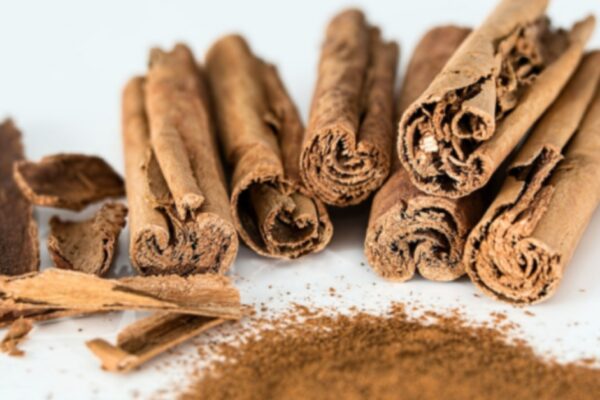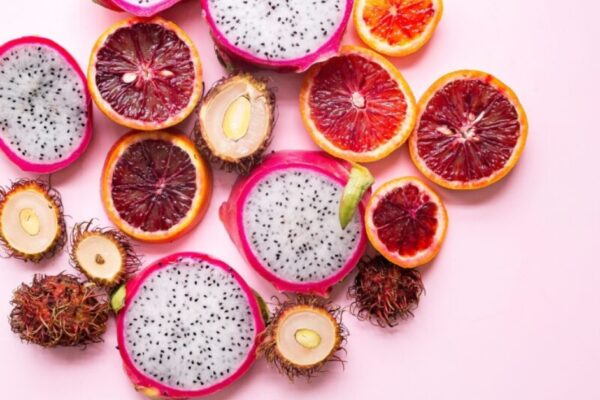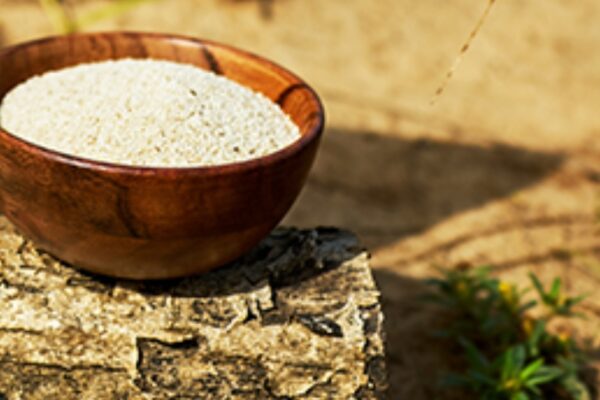Cacao tree or (Cocoa tree) Theobroma cacao is the raw material behind the products that are dear to the hearts of many. These include chocolate, cacao or cocoa powder, cocoa butter (or cacao butter), chocolate liquor, and cacao nibs (or cocoa nibs). Since cacao is raw, it possesses various health benefits and also aids in boosting weight loss.
The consumption of cacao is constantly increasing and projections show that this upward trend will continue over the coming years. Cacao is also gaining popularity amongst researchers due to its healthy properties, which mainly come from its high content of polyphenols.
According to the Fortune Business Insights 2020 market research report, the estimated value of the global cocoa and chocolate market size in 2019 was USD 44.35 billion. Projections show that the market will continue to increase at a compound annual growth rate (CAGR) of 4.6% until 20271.
What is it? | Nutritional Benefits | Recommended dosage | Recipe ideas | Where to buy
The Cacao Tree
The cacao tree is a small, evergreen tree native to Central and South America.
Cacao beans were first brought over to Europe by Christopher Columbus. Later, Hernán Cortés, gave cacao samples to King Charles V of Spain in 1528. Since the hot and humid climate around the equator provides the perfect conditions for cultivation, its production then extended into many tropical countries.
Today, there are around sixty countries growing cacao around the world. Around 70% of the world’s supply comes from Africa, with the Ivory Coast and Ghana being the two major producers. These two countries jointly provide half of the world’s cacao. The next largest countries producing cacao are Indonesia, Nigeria, Brazil, Cameroon, Ecuador, the Dominican Republic, Peru, and Colombia2.
There are over 10 types cacao beans (or cocoa beans), and are usually classified into the following three main categories:
- Forastero – the robust and most widely grown cacao.
- Criollo – higher quality cacao and also more expensive.
- Trinitario – a hybrid of the above two varieties.
Cacao powder and chocolate are obtained from cacao beans, which are the seeds of the tropical crop of the cacao tree. These are then passed through the processes of fermentation and drying to produce many of the cacao-based products that we have available in the market3.
Cacao vs Cocoa
When buying chocolate, you’ll probably notice that the label on some packages says “cacao” and on others “cocoa”. When speaking, both words are also used interchangeably. However, to chocolate makers and chocolatiers, these two words refer to different things.
Starting from the basics, both cacao and cocoa come from the Theobroma cacao tree. They both start as beans that are harvested, processed, and then transformed into a multitude of different products.
Some experts refer to the pods, beans, and ground-up contents of the beans as “cacao”4. Here cacao tends to refer to unroasted or less processed cacao bean products, and so implies more natural products. On the other hand, “cocoa” is used for beans that have undergone fermentation after being harvested.
Cacao beans are said to contain numerous health benefits as they contain high levels of antioxidants, fiber, lipids, and minerals. Since cacao is raw, processing of the beans doesn’t destroy the health benefits of cacao. The processing of cacao beans is what makes cacao beans develop flavor and texture. Normally, the label on a bar shows the percentage of cacao, cocoa, or dark chocolate it contains and tells you the composition of cocoa powder and cocoa butter.
Cacao products such as unsweetened cocoa powder, nibs, and dark chocolate are rich sources of minerals, like selenium, magnesium, chromium, and manganese. When raw cacao products have been minimally processed they contain little or no added sugar and are higher in antioxidants than more highly processed products5.
Health Benefits of Cacao
Cacao beans are highly nutritious due to their high polyphenol content. Polyphenols are micronutrients that we get through certain plant-based foods, like cloves, berries, beans, beetroots, and nuts. Polyphenols in cacao beans and cocoa products comprise mainly flavonol glycosides, procyanidins, catechins, anthocyanins, that contain a significant amount of antioxidants and anti-inflammatory properties. All these properties contribute towards blood sugar control, better blood flow, lower blood pressure, and improved cholesterol levels6. However, the polyphenol content in different cocoa products varies.
Cacao beans are amongst the richest sources of flavanols (around 60% of total phenolics are in raw beans). For this reason, cacao is a major contributor of flavonoids to our dietary intake. Flavanols or procyanidins are a subclass of flavonoids that can potentially decrease certain risk factors for cardiovascular diseases since they improve cholesterol levels and decrease the risk of blood clots. Particularly procyanidins, also have anti-inflammatory properties that may be beneficial to those suffering from Irritable Bowel Syndrome (IBS)7.
When it comes to flavonoid content, flavonoids in cacao are much higher than those found in red wine, green tea, and black tea. In addition, the darker the chocolate the higher the flavonoids8.
The following are 7 key health benefits if you include cacao-based products in your diet.
1. Blood Pressure
High blood pressure or hypertension poses significant risks to cardiovascular health. It contributes to circa 50% of cardiovascular health causes worldwide. It also contributes to 37% of cardiovascular-related deaths in Western populations.
Scientific studies suggest that the flavanols found in cacao and cocoa products decrease the risk of cardiovascular disease. Particularly, studies show that flavanols increase the formation of endothelial nitric oxide which is a vasodilator that relaxes the inner muscles of your blood vessels. This causes blood vessels to widen which then lowers your blood pressure. Moderate-quality evidence shows that 30 mg to 1,218 mg of cacao flavanols can reduce blood pressure by an average of 2 mmHg9.
2. Heart Health
Observational studies show that consuming cacao as cocoa powder and/or dark cocoa chocolate, is effective in lowering the risk of developing or dying from cardiovascular disease10,11. Studies show those who ate more dark chocolate had lower blood pressure and were susceptible to a lower risk of stroke12. When compared to individuals who never eat chocolate, individuals who ate chocolate twice a week and who had a previous heart attack, were 66% less likely to die from heart disease13.
Cacao also has a blood-thinning effect similar to aspirin. As a result, it is effective in reducing “bad” LDL cholesterol14, and in lowering the risk of blood clots. Together, these contribute towards lowering the risk of a heart attack or stroke15.
3. Brain Power
Studies show that polyphenols, mainly the flavonoids in cacao and chocolate improve the blood flow and blood supply to your brain. This results in improved cognitive functions16.
A two-week study conducted on adults aged 35 years who consumed high-flavanol cocoa, showed that their blood flow to the brain increased by 8% after one week and 10% after two weeks17.
4. Mood Booster
Cacao and dark chocolate contain tryptophan, which is an amino acid that your brain uses to produce the natural mood-stabilizing hormone, serotonin. Together with the other compounds that cacao and dark chocolate contain, like anandamide (a little brain chemical known as the “bliss molecule” for the feeling of euphoria it produces)18, and theobromine (a mild stimulant), result in feelings of overall happiness and lowers stress levels19.
5. Weight Loss Enhancer
Cacao and dark chocolate appear to result in feelings of fullness by reducing appetite and inflammation and increasing fat oxidation (breaking down of fats)20.
A study particularly comprised men and women aged 19-67 years who were divided equally into three groups. Two groups followed a low-carb diet, one of which also consumed chocolate, whilst the third group followed a regular diet. The group consuming daily 42 grams of chocolate with 81% cocoa content, experienced faster weight loss than the regular diet group21.
Another study revealed that those who consumed chocolate more often had a lower BMI than those who ate chocolate less often. These results were obtained despite the former group also ate more calories and fat22.
6. Immune Support
Since cacao is relatively rich in polyphenols, it contains compounds rich in antibacterial, anti-enzymatic, and immune-stimulating properties.
A 2013 study showed that a cocoa diet is able to modify intestinal microbiota that can be beneficial in certain immune processes23. However, further research is required on this topic.
7. Skin benefits
Since cacao powder is also naturally rich in antioxidants, it helps to neutralize the damaging effects of free radicals on the skin. These antioxidants also increase collagen production and cellular healing that also delay signs of ageing24.
Cacao Daily Recommended Dosage
The European Food Safety Authority recommends that you should consume at least 200 mg of flavanols per day to experience the health benefits that this cacao superfood offers25. This dosage translates into the following26:
- around 2.5 grams of high-flavanol cacao or cocoa powder, or
- 10 grams of high-flavanol dark chocolate.
Recipes with Cacao Powder
Adding cacao powder to your daily diet is relatively quick and easy. You can start by simply mixing it into smoothies, sprinkle it on your breakfast, or include it in your baking recipes. Here are some guilt-free scrumptious recipes that you should try.

- Drink Recipes: Super-Cacao Hot Chocolate, Super-Cacao Coconut Water
- Breakfast Recipes: Cacao Nib Chia Pudding, Cinnamon Spiced Cacao Porridge (see here why to use Ceylon cinnamon), Cacao & Mango Overnight Oats, Super-Cacao Smoothie Bowl, Cacao-Orange Fonio Porridge, Super-Cacao Pancakes
- Condiment Recipes: Cacao Balsamic Vinegar
- Main Dish Recipes: Courgetti Bolognese with Cacao
- Smoothie Recipes: Super Nutty Cacao Smoothie
- Sweet Recipes: Dairy-Free Chocolate Almond Ice Cream Cups, Easy Vegan Chocolate, Cacao & Moringa Donuts, Cacao Bliss Balls, Moringa & Cacao Cookies, Hazelnut Cacao Mousse Cups, Fudgy Flourless Protein Brownies, Low-Carb Keto Fudge Banana Truffles, Super-Cacao & Maca Brownies, Healthy Super-Cacao Nutella
Where to buy Cacao Powder

Personally, I love Aduna Super-Cacao Powder for its delicious and rich chocolatey flavor and is the best cacao powder I have tasted so far. Aduna’s cacao powder is sourced from high-flavanol cacao beans in Ghana.
It also contains 33% of fiber that serves as a natural boost to the body’s digestive enzymes and aids in the absorption of nutrients. This results in improved gut health and bowel regularity. Since it is rich in fiber, net carbs are lower. This makes cacao superfood powder also ideal for those following a low-carb, keto diet.
If you want to view the full list of nutrients found in Aduna Super-Cacao Powder, you can check out their nutritional table.
Aduna Super-Cacao Powder is available directly from aduna.com or amazon.de for EU residents and amazon.com for US residents. If you are a Maltese resident, you can shop this product from Greens Supermarket, Flavours for Health, and Nutrition Empire.
*This post includes suggestions for products that Lifestyle Exquisite thinks are useful to its readers. If you buy through links on this page, a small commission may be earned.
Sources
2 Food and Agriculture Organization (FAO) of the United Nations.
3 Cocoa: Production, Chemistry, and Use. A. Caligiani, A. Marseglia, G. Palla. Editor(s): Benjamin Caballero, Paul M. Finglas, Fidel Toldrá. Encyclopedia of Food and Health, Academic Press, 2016, Pages 185-190, ISBN 9780123849533. https://doi.org/10.1016/B978-0-12-384947-2.00177-X.
4 Emmanuel Ohene Afoakwa BSc, MPhil, PhD, Postgraduate. Chocolate Science and Technology. . 19 February 2010.
5 Cinquanta L, Di Cesare C, Manoni R, Piano A, Roberti P, Salvatori G. Mineral essential elements for nutrition in different chocolate products. Int J Food Sci Nutr. 2016 Nov;67(7):773-8. doi: 10.1080/09637486.2016.1199664. Epub 2016 Jun 26. PMID: 27346251.
6 Ludovici V, Barthelmes J, Nägele MP, Enseleit F, Ferri C, Flammer AJ, Ruschitzka F, Sudano I. Cocoa, Blood Pressure, and Vascular Function. Front Nutr. 2017 Aug 2;4:36. doi: 10.3389/fnut.2017.00036. PMID: 28824916; PMCID: PMC5539137.
7 Bitzer ZT, Glisan SL, Dorenkott MR, et al. Cocoa procyanidins with different degrees of polymerization possess distinct activities in models of colonic inflammation. J Nutr Biochem. 2015;26(8):827-831. doi:10.1016/j.jnutbio.2015.02.007
8 Lee KW. Cocoa has more phenolic phytochemicals and a higher antioxidant capacity than teas and red wine. J Agric Food Chem. 2003;51:7292–5.
9 Ried K, Fakler P, Stocks NP. Effect of cocoa on blood pressure. Cochrane Database Syst Rev. 2017 Apr 25;4(4):CD008893. doi: 10.1002/14651858.CD008893.pub3. PMID: 28439881; PMCID: PMC6478304.
10 Brian Buijsse, Cornelia Weikert, Dagmar Drogan, Manuela Bergmann, Heiner Boeing, Chocolate consumption in relation to blood pressure and risk of cardiovascular disease in German adults, European Heart Journal, Volume 31, Issue 13, July 2010, Pages 1616–1623,
11 Kwok CS, Boekholdt SM, Lentjes MA, Loke YK, Luben RN, Yeong JK, Wareham NJ, Myint PK, Khaw KT. Habitual chocolate consumption and risk of cardiovascular disease among healthy men and women. Heart. 2015 Aug;101(16):1279-87. doi: 10.1136/heartjnl-2014-307050. Epub 2015 Jun 15. Erratum in: Heart. 2018 Mar;104(6):532. PMID: 26076934; PMCID: PMC6284792.
12 Larsson SC, Virtamo J, Wolk A. Chocolate consumption and risk of stroke: a prospective cohort of men and meta-analysis. Neurology. 2012 Sep 18;79(12):1223-9. doi: 10.1212/WNL.0b013e31826aacfa. Epub 2012 Aug 29. PMID: 22933736.
13 Janszky I, Mukamal KJ, Ljung R, Ahnve S, Ahlbom A, Hallqvist J. Chocolate consumption and mortality following a first acute myocardial infarction: the Stockholm Heart Epidemiology Program. J Intern Med. 2009 Sep;266(3):248-57. doi: 10.1111/j.1365-2796.2009.02088.x. PMID: 19711504.
14 Xiaochen Lin, Isabel Zhang, Alina Li, JoAnn E Manson, Howard D Sesso, Lu Wang, Simin Liu, Cocoa Flavanol Intake and Biomarkers for Cardiometabolic Health: A Systematic Review and Meta-Analysis of Randomized Controlled Trials, The Journal of Nutrition, Volume 146, Issue 11, November 2016, Pages 2325–2333,
15 Flammer AJ, Hermann F, Sudano I, Spieker L, Hermann M, Cooper KA, Serafini M, Lüscher TF, Ruschitzka F, Noll G, Corti R. Dark chocolate improves coronary vasomotion and reduces platelet reactivity. Circulation. 2007 Nov 20;116(21):2376-82. doi: 10.1161/CIRCULATIONAHA.107.713867. Epub 2007 Nov 5. PMID: 17984375.
16 Nehlig A. The neuroprotective effects of cocoa flavanol and its influence on cognitive performance. Br J Clin Pharmacol. 2013 Mar;75(3):716-27. doi: 10.1111/j.1365-2125.2012.04378.x. PMID: 22775434; PMCID: PMC3575938.
17 Sorond FA, Lipsitz LA, Hollenberg NK, Fisher ND. Cerebral blood flow response to flavanol-rich cocoa in healthy elderly humans. Neuropsychiatr Dis Treat. 2008;4(2):433-440.
18 Scherma M, Masia P, Satta V, Fratta W, Fadda P, Tanda G. Brain activity of anandamide: a rewarding bliss?. Acta Pharmacol Sin. 2019;40(3):309-323. doi:10.1038/s41401-018-0075-x.
19 Becker K, Geisler S, Ueberall F, Fuchs D, Gostner JM. Immunomodulatory properties of cacao extracts – potential consequences for medical applications. Front Pharmacol. 2013 Dec 12;4:154. doi: 10.3389/fphar.2013.00154. PMID: 24376420; PMCID: PMC3859901.
20 Farhat G, Drummond S, Fyfe L, Al-Dujaili EA. Dark chocolate: an obesity paradox or a culprit for weight gain? Phytother Res. 2014 Jun;28(6):791-7. doi: 10.1002/ptr.5062. Epub 2013 Sep 2. PMID: 24000103.
21 Bohannon, Johannes & Koch, Diana & Homm, Peter & Driehaus, Alexander. (2015). Chocolate with high Cocoa content as a weight-loss accelerator. International Archives of Medicine. 8. 10.3823/1654.
22 Golomb BA, Koperski S, White HL. Association between more frequent chocolate consumption and lower body mass index. Arch Intern Med. 2012;172(6):519-521. doi:10.1001/archinternmed.2011.2100.
23 Pérez-Cano FJ, Massot-Cladera M, Franch A, Castellote C, Castell M. The effects of cocoa on the immune system. Front Pharmacol. 2013;4:71. Published 2013 Jun 4. doi:10.3389/fphar.2013.00071.
24 Scapagnini G, Davinelli S, Di Renzo L, et al. Cocoa bioactive compounds: significance and potential for the maintenance of skin health. Nutrients. 2014;6(8):3202-3213. Published 2014 Aug 11. doi:10.3390/nu6083202.
25 European Food Safety Authority (EFSA): Scientific Opinion on the modification of the authorisation of a health claim related to cocoa flavanols and maintenance of normal endothelium-dependent vasodilation pursuant to Article 13(5) of Regulation (EC) No 1924/2006 following a request in accordance with Article 19 of Regulation (EC) No 1924/2006.
26 Healthline: 11 Health and Nutrition Benefits of Cocoa Powder. 2018.





